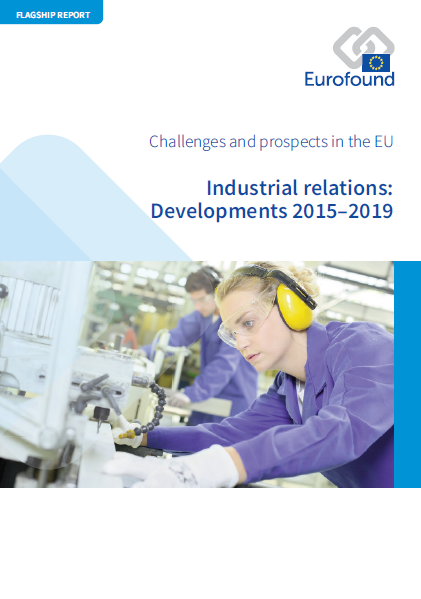
As part of its mandate to promote dialogue between management and labour, Eurofound has monitored and analysed developments in industrial relations systems at EU level and in EU Member States for over 40 years. This flagship report is based on the work done in this context during the last programming period (2015–2019). It draws on the extensive monitoring of industrial relations systems and social dialogue carried out by Eurofound on an ongoing basis. The overall aim of the report is to assist policymakers and industrial relations actors both to understand the challenges facing social dialogue and to identify possible ways to contribute to balanced and well-functioning industrial relations systems going forward.
Key findings
At European level, there has been an impressive volume of joint initiatives that have emerged from European social dialogue, but there have been few agreements.
There is concern in some sectors that social partner requests for implementation of their agreements through European legislation have been rejected, and that better links between EU and national levels are needed.
At national level, industrial relations remain very diverse within the EU. Eurofound’s analysis suggests a clear division between countries (Nordic and continental) recording the best scores in industrial democracy and southern, liberal and central and eastern (CEE) Member States.
Fewer than one in three workplaces (with 10+ workers) in the EU (29%) has some form of employee representation. Legislative requirements are a key driver for the presence of such representation.
Investing in social dialogue in ‘good times’ helps to ensure that it can be depended on in times of crisis. A review of first policy responses to the COVID-19 pandemic shows that social partner involvement was generally more robust in those countries where social dialogue has traditionally played an important role.
List of tables
Table 1: Main EU cross-sectoral joint texts, November 2014–November 2019
Table 2: European Pillar of Social Rights
Table 3: Results of the mapping exercise on capacity gaps and needs among national social partners
Table 4: Social partners’ involvement in social and labour policymaking
Table 5: Recitals with explicit references to capacity building in the 2019 CSRs
Table 6: Contextual indicators for industrial democracy
Table 7: Dimensions and indicators of industrial democracy
Table 8: Industrial democracy clusters in the EU27 and the UK, 2008–2012 and 2013–2017
Table 9: Selected developments in social partner organisations, 2014–2019
Table 10: Member States in which respondents were most and least likely to have received training as an employee representative
Table 11: Employee representatives perceiving levels of appreciation from employees by industrial democracy cluster (%)
Table 12: Direct and indirect forms of employee involvement in the most important organisational change
Table 13: Views of management and employee representatives on the degree of influence of employees and their representatives
Table 14: Extent of mutual trust between employee representatives and management (%)
Table A1: Types of employee representatives included in the ECS 2019
List of figures
Figure 1: European social dialogue outcomes by type of text (as at 29 July 2020)
Figure 2: National social partners’ involvement in peak-level social dialogue in 2018
Figure 3: Trade union density rates by industrial democracy cluster, 2000, 2014 and 2018 (%)
Figure 4: Collective bargaining coverage rates by industrial democracy cluster, 2000, 2014 and 2018 (%)
Figure 5: Private sector collective bargaining coverage and patterns by industrial democracy cluster, 2019 (%)
Figure 6: Prevalence and type of workplace-level employee representation by country and industrial democracy cluster (%)
Figure 7: Proportion of employees covered by official employee representation by industrial democracy cluster
Figure 8: Proportion of companies in the ECS to which certain legal rules and size thresholds on employee representation apply
Figure 9: Probability that any form of employee representation will exist in an establishment by establishment size and sector (%)
Figure 10: Influence of legal rules and thresholds on probability of representation (%)
Figure 11: Influence of company employment developments, competitiveness and workforce structure on probability of representation (%)
Figure 12: Years of experience as an employee representative by gender (%)
Figure 13: Proportion of respondents by type of representation and establishment size
Figure 14: Working time available to employee representatives by industrial democracy cluster (%)
Figure 15: Training for employee representatives by type and establishment size (%)
Figure 16: Access of employee representatives to funding for external advice by type of representation and establishment size (%)
Figure 17: Proportion of employee representatives reporting estimated shares of trade union membership in their establishments (%)
Figure 18: Employee representatives meeting with employees during and outside working hours (%)
Figure 19: Existence and use of a dedicated social media account to communicate with employees by length of experience of the employee representative (%)
Figure 20: Employee representatives receiving information (financial, employment and strategic) from management by industrial democracy cluster (%)
Figure 21: Employee representatives expressing satisfaction with the quality of information and reporting receiving it in good time (%)
Figure 22: Employee representatives’ involvement in various types of pay negotiations (%)
Figure 23: Employee representatives’ involvement in pay negotiations by industrial democracy cluster (%)
Figure 24: Employee representatives’ involvement in pay negotiations by type of representation (%)
Figure 25: Employee representatives reporting organisational changes since 2016 (%)
Figure 26: Areas of most important change since 2016, as reported by employee representatives (%)
Figure 27: Involvement of employee representatives in the most important organisational change by industrial democracy cluster (%)
Figure 28: Initiator and form of social dialogue (%)
Figure 29: Forms of indirect and direct employee involvement in the most important organisational change (%)
Figure 30: Distribution of combinations of direct and indirect employee involvement by type of employee representation (%)
Figure 31: Employee representatives’ views on direct involvement of employees (%)
Figure 32: Employee representatives’ views on influence of representatives and employees on major organisational changes (%)
Figure 33: Employee representatives’ views on great or moderate influence of employees and representatives on organisational change by area (%)
Figure 34: Employee representatives’ views on levels of trust in management and whether management listens (%)
Figure 35: Trust in and relationship with management by frequency of meeting (%)
- Number of pages
-
120
- Reference nº
-
EF20023
- ISBN
-
978-92-897-2137-0
- Catalogue nº
-
TJ-06-20-066-EN-N
- DOI
-
10.2806/994718
- Permalink
Cite this publication
Eurofound (2020), Industrial relations: Developments 2015–2019, Challenges and prospects in the EU series, Publications Office of the European Union, Luxembourg

